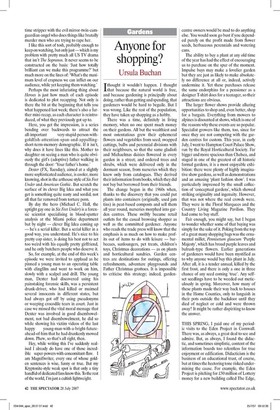Anyone for shopping?
Ursula Buchan Ithought it wouldn't happen. I thought that because the natural world is free, and because gardening is principally about doing, rather than getting and spending, that gardeners would be hard to beguile. But I was wrong. Like the rest of the population, they have taken up shopping as a hobby.
There was a time, definitely in living memory, when no one spent much money on their gardens. All but the wealthiest and most ostentatious grew their ephemeral flowers and vegetables from seed; swapped cuttings, bulbs and perennial divisions with their neighbours, so that the same gladioli and Michaelmas daisies flowered in every garden in a street; and ordered trees and shrubs, which were delivered only in the dormant season, from nurseries which they knew only from catalogues. They derived their information from books, which they did not buy but borrowed from their friends.
The change began in the 1960s when, thanks to the discovery that you could put plants into containers (originally, used jam tins) in peat-based composts and sell them all year round, nurseries morphed into garden centres. These swiftly became retail outlets for the casual browsing shopper as well as the committed gardener. Anyone who reads the trade press will know that the emphasis is as much on how to make profits out of items to do with leisure — barbecues, sunloungers, pet treats, children's toys, Christmas decorations — as on plants and horticultural sundries. Garden centres are destinations for outings, offering refreshments, adventure playgrounds and Father Christmas grottoes. It is impossible to criticise this strategy; indeed, gardencentre owners would be mad to do anything else. You would soon go bust if you depended purely on the profit made from flower seeds, herbaceous perennials and watering cans.
The ability to buy a plant at any old time of the year has had the effect of encouraging us to purchase on the spur of the moment. Impulse buys may make a lovelier garden but they are just as likely to make absolutely no difference at all or, indeed, actively undermine it. Yet these purchases release the same endorphins for a pensioner as a designer T-shirt does for a teenager, so their attractions are obvious.
The larger flower shows provide alluring opportunities to shop and, even better, shop for a bargain. Everything from mowers to alpines is disounted at shows, which is one of the reasons why these events are so popular. Specialist growers like them, too, since for once they are not competing with the garden centres for custom. This year, in early July, I went to Hampton Court Palace Show, run by the Royal Horticultural Society. Far bigger and more spacious than Chelsea, and staged in one of the greatest of all historic formal gardens, it is a most enjoyable exhibition: there were plenty of highly imaginative show gardens, as well as demonstrations and an amusing 'plant fashion show'. I was particularly impressed by the small collection of 'conceptual gardens', which showed striking originality and ingenuity. However, that was not where the real crowds were. They were in the Floral Marquees and the Country Living Magazine Pavilion. They had come to buy stuff.
Fair enough, you might say, but I began to wonder whether some of that buying was simply for the sake of it. Poking from the top of a great many shopping bags was the ornamental millet, Pennisetum glaucum 'Purple Majesty', which has broad purple leaves and bulrush-type flowers. Earlier generations of gardeners would have been mystified as to why anyone would buy this plant in July. After all, it is a tender annual, killed by the first frost, and there is only a one in three chance of any seed coming 'true'. Any selfset seedlings have to be weeded out meticulously in spring. Moreover, how many of these plants made their way back to houses in the Home Counties, only to languish in their pots outside the backdoor until they died of neglect or cold and were thrown away? It might be rather dispiriting to know the answer.
THIS SPRING, I paid one of my periodic visits to the Eden Project in Cornwall. There was, as always, a great deal to see and admire. But, as always, I found the didactic, and sometimes simplistic, content of the information boards too relentless for true enjoyment or edification. Didacticism is the business of an educational trust, of course, but at times the hectoring tone risked undermining the cause. For example, the Eden Project is pitching for £50 million of Lottery money for a new building called The Edge, where the public can learn about the impact and challenges of climate change. What could be more worthy or more important? The guidebook reads: ' ... as a wise person once said, "If you're not on the edge, you're taking up too much space."' As my husband, also a wise person, said, 'Nonsense written in a good cause is still nonsense.'









































 Previous page
Previous page